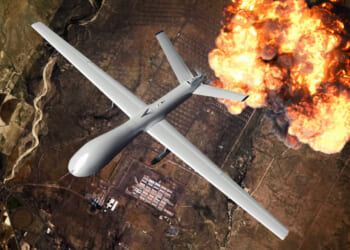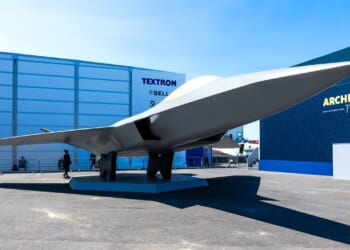No matter how impressive the specs on these warships are, they will be relatively useless in the face of the size and scope of the incoming Chinese invasion.
In recent months, Taiwan has continued its quixotic attempt to emulate the United States military—even as the People’s Republic of China, its single-greatest threat just across the Taiwan Strait, builds up its own forces at unprecedented levels. More recently, Taiwan’s deputy foreign minister shared his fear, based upon the relentless and large Chinese military exercises around Taiwan, that a Chinese attack against Taiwan was coming soon.
In response to these fears, the Taiwanese are struggling to make their indigenous military as self-sufficient and potent as possible to better stop any Chinese invasion.
Why Taiwan’s Defense Strategy Misses the Mark
But Taiwan’s preparations for this possible Chinese invasion are only partially correct. Fashioning Taiwan’s military into a miniature US military, replete with warplanes and warships, might make the government in Taipei feel good. But it is completely unrealistic. Taiwan will never be able to replicate the capabilities that undergird America’s military might. Taipei’s attempts to do so are simply wasting precious time, money, and resources that in no way will stop a real Chinese attack on Taiwan. Instead, Taiwan needs to be preparing for an insurgency against an invading Chinese military—a drawn-out conflict that would dramatically raise the cost of an invasion and complicate Beijing’s cost-benefit analysis. That is not something that can be accomplished by purchasing and building legacy platforms.
Understanding the Kang Ding-Class Frigate
Take, for instance, the new Kang Ding-class frigate. Derived from the French La Fayette-class design, this warship has its origins back to the early 1990s. At that time, the Republic of China Navy (ROCN), Taiwan’s navy, wanted to modernize its fleet amid growing regional pressures. In a landmark USD $1.75 billion deal with France’s DCNS defense conglomerate, Taiwan acquired six frigates based on the innovative La Fayette-class, renowned for its stealth features that reduced radar visibility.
The ships—named Kang Ding (PFG-1202), Si Ning (PFG-1203), Kun Ming (PFG-1205), Di Hua (PFG-1206), Wu Chang (PFG-1207), and Chen De (PFG-1208)—were constructed between 1993 and 1996, with commissioning from 1996-98. That acquisition was overshadowed by a notorious financial scandal, which involved alleged kickbacks and even the mysterious death of a Taiwanese naval officer.
To further complicate matters, France withheld key weapon systems for the frigates after Chinese pressure, forcing Taiwan to integrate American and domestically-produced alternatives. This compromise initially limited capabilities, but the frigates still represented a major leap forward for the ROCN, enhancing sea control beyond coastal ranges.
Legal repercussions from the scandal have persisted since the 1990s, with Switzerland returning nearly 266 million US dollars to Taiwan in 2021 from frozen accounts linked to arms dealer Andrew Wang. Despite these hurdles, however, the Kang Ding-class has served reliably for over 25 years, adapting to Taiwan’s defensive posture focused on the Taiwan Strait.
The Kang Ding-Class Frigate’s Specs
- Year Introduced: 1996
- Number Built: 6
- Length: 125 m (410 ft)
- Beam (Width): 15.4 m (51 ft)
- Displacement: 3,200 tons empty, 3,800 fully provisioned
- Engines: 4 SEMT Pielstick 12PA6V280 STC2 diesel engines; 21,000 horsepower total
- Top Speed: 25 knots (29 mph)
- Range: 9,000 nautical miles (10,350 mi)
- Armaments: 1 Oto Melara 76mm/62 Mk 75 cannon; 8 Hsiung Feng II missiles; Phalanx CIWS and Bofors 40mm L70 autocannon
- Crew: 141 (12 officers, 68 petty officers, 61 enlisted)
The Kang Ding-class frigate has angled surfaces minimizing radar returns, embodying stealth engineering. The frigates carry 350 tons of fuel, 80 cubic meters of kerosene, and 60 tons of water, supporting 50 days of endurance at sea. There is also a hangar and helipad for a Sikorsky S-70C(M) anti-submarine warfare (ASW) helicopter, plus two ETN support boats.
The frigate’s armor protects vital areas like ammunition magazines and command centers, making the Kang Ding-class versatile for escort, blockade defense, and joint operations. Air defense initially relied on the RIM-72C Sea Chaparral system, with a limited range—criticized as inadequate against modern threats, like anti-ship missiles. This setup emphasized ASW and surface attack, aligning with Taiwan’s strategy to counter submarine and amphibious incursions. Operationally, the class has participated in patrols, exercises, joint drills, all of which are primed at maintaining readiness for sea control mission sets.
The Kang Ding’s New Upgrades Are Mostly Useless
Recognizing evolving threats, Taiwan launched a USD $1.37 billion upgrade program for these warships in 2021. Led by the National Chung-Shan Institute of Science and Technology (NCSIST), a somewhat oddly named state-run defense innovation firm, the initiative replaces the outdated DRBV-26D Jupiter II radar with BAE Systems’ Type 997 Artisan 3D radar capable of tracking over 200 targets at extended ranges.
The Sea Chaparral has been upgraded to the indigenous Hua Yang vertical launch system (VLS), accommodating 32 TC-2N medium-range missiles with a range of more than 30 miles away—quadrupling capacity and extending defense. The first upgraded ship in the class, the Chen De (PFG-1208), began sea trials in late July 2025, with delivery expected by September of this year. Subsequent upgrades will proceed at one per year until 2030, including new combat management systems and fiber-reinforced masts for reduced signature.
But if the Chinese military is planning to attack Taiwan between now and the year 2027—the year most commonly cited in US military forecasts—how will these expensive warships even be useful for Taiwan? Imagine the money that they spent on these six relatively useless warships having been spent on establishing and expanding the infrastructure to support an island-wide insurgency.
The bottom line is that no matter how impressive the specs on these warships are, they will be relatively useless in the face of the size and scope of the Chinese invasion that is likely coming soon. Small arms, anti-tank and anti-aircraft systems, and swarms of low-cost drones are all far more valuable to Taiwan right now than six warships will ever be.
About the Author: Brandon J. Weichert
Brandon J. Weichert is a senior national security editor at The National Interest. He is also a contributor at Popular Mechanics, and has consulted regularly with various government institutions and private organizations on geopolitical issues. Weichert’s writings have appeared in multiple publications, including The Washington Times, National Review, The American Spectator, MSN, The Asia Times, and countless others. His books include Winning Space: How America Remains a Superpower, Biohacked: China’s Race to Control Life, and The Shadow War: Iran’s Quest for Supremacy. His newest book, A Disaster of Our Own Making: How the West Lost Ukraine is available for purchase wherever books are sold. He can be followed via Twitter @WeTheBrandon.
Image: Wikimedia Commons.

















